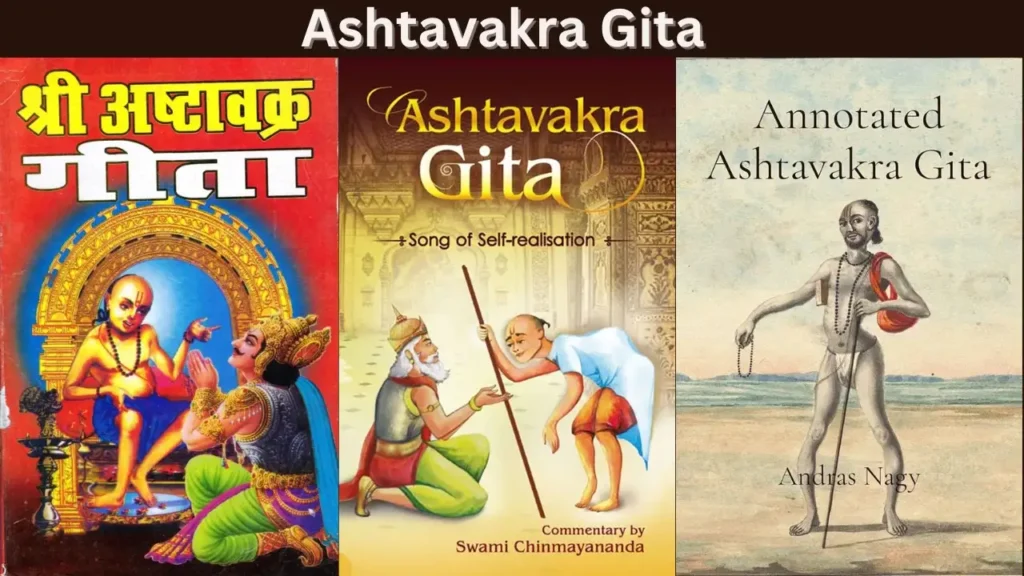The Ashtavakra Gita, often referred to as the “Song of Ashtavakra,” is a profound spiritual text that explores the nature of the self, reality, and liberation. Unlike other Indian scriptures, it is direct, uncompromising, and rooted in Advaita Vedanta (non-dual philosophy). Believed to be a dialogue between the sage Ashtavakra and King Janaka, this ancient text focuses on self-realization and the transcendence of duality.
This article will delve into the essence of the Ashtavakra Gita, highlight the best translations like Osho’s interpretation, compare it with the Bhagavad Gita, and provide insights on accessing the Ashtavakra Gita PDF for deeper exploration.
Who Was Ashtavakra?
Ashtavakra was a sage known for his wisdom despite his physical deformities—hence the name “Ashtavakra,” meaning “eight bends.” His teachings transcend societal norms and focus solely on the ultimate truth of existence.
Ashtavakra’s Philosophy:
- Non-Duality (Advaita): There is no separation between the self and the universal consciousness.
- Direct Liberation: Liberation does not require rituals or prolonged practices; it is an immediate realization of the self’s true nature.
- Freedom from Ego: The ego creates the illusion of separation and bondage.
What Is the Ashtavakra Gita?
This Gita is a concise scripture comprising 20 chapters and around 298 verses. It stands out for its simplicity and radical approach to self-realization.
Key Themes:
- Oneness with the Universe: There is no duality between the observer and the observed.
- Illusory Nature of the World: The material world is a projection of the mind.
- Effortless Awareness: Enlightenment is achieved by recognizing your inherent divinity, not by striving for it.
The dialogue between Sage Ashtavakra and King Janaka provides timeless wisdom on detachment, consciousness, and the nature of true happiness.
Unique Teachings of the Ashtavakra Gita
| Teaching | Explanation |
| You Are Already Free | Liberation is not something to be attained; it is your natural state. |
| The World Is Maya (Illusion) | The world’s reality is a projection of the mind and does not exist independently. |
| Detachment from Mind and Body | Your true self is beyond physical existence and mental constructs. |
| Silence and Stillness | True knowledge arises from silence, not from intellectual pursuits. |
These teachings align with Advaita Vedanta, emphasizing self-realization and the non-dual nature of existence.
Ashtavakra Gita vs Bhagavad Gita
The Ashtavakra Gita and Bhagavad Gita are both revered texts, but they differ significantly in tone, context, and approach.
| Aspect | Ashtavakra Gita | Bhagavad Gita |
| Context | A dialogue between Sage Ashtavakra and King Janaka on self-realization. | A conversation between Krishna and Arjuna during the Kurukshetra war. |
| Philosophy | Pure Advaita (non-duality); direct realization of the self. | Combination of Karma Yoga, Bhakti Yoga, and Jnana Yoga. |
| Approach | Rejects rituals and external practices. | Encourages action with detachment and devotion. |
| Tone | Direct, uncompromising, and introspective. | Practical, motivational, and broad in its teachings. |
Both texts offer profound insights, but this Gita is often seen as suited for advanced seekers who are ready to embrace non-duality without the framework of action or devotion.
Ashtavakra Gita Best Translation by Osho
Osho, a modern spiritual teacher, has provided one of the most profound and accessible interpretations of the Ashtavakra Gita.
Why Osho’s Translation Stands Out:
- Clarity: Osho breaks down the complex ideas of non-duality into relatable concepts.
- Practical Insights: His commentary bridges ancient wisdom with contemporary challenges.
- Focus on Inner Freedom: Osho emphasizes how the Ashtavakra Gita can lead to personal liberation in today’s world.
Readers can explore this translation to gain a deeper understanding of the text’s transformative teachings.
How to Access Ashtavakra Gita PDF
For seekers who want to study the scripture in-depth, digital resources like this Gita PDF are invaluable.
Where to Find:
- Official spiritual websites and archives.
- Online repositories like archive.org and other public domain resources.
- Some editions of Osho’s translations also include downloadable PDFs.
Clisk here to download the PDF OF ASTAVAKRA GITA
These PDFs often include original verses in Sanskrit, translations, and detailed commentaries, making them ideal for study and reflection.
Practical Applications of the Ashtavakra Gita
The teachings of this Gita are not just theoretical; they offer practical guidance for living a liberated life.
- Let Go of Attachments:
- Practice observing your thoughts and emotions without identifying with them.
- Recognize that true happiness comes from within, not external achievements.
- Embrace Non-Resistance:
- Accept life’s challenges as they come, understanding that resistance creates suffering.
- Meditation on Awareness:
- Focus on the present moment and experience the stillness within.
- Use silence as a tool for self-realization.
- Shift Perspective:
- See the world as a reflection of your inner state.
- Align your actions with the understanding of oneness and interconnectedness.
Comparison Table: Key Concepts in This Gita
| Concept | Explanation | Practical Takeaway |
| Self-Realization | You are not the body or mind but pure consciousness. | Meditate to detach from ego and align with your true self. |
| Detachment | True liberation comes from letting go of desires and fears. | Focus on what matters without clinging to outcomes. |
| Silence and Stillness | Wisdom emerges when the mind is quiet. | Practice mindfulness and silence daily. |
| Unity of Existence | There is no separation between you and the universe. | Treat others with compassion, recognizing shared divinity. |
FAQs
Q1. What is the Ashtavakra Gita about?
Ans. It is a spiritual text focusing on self-realization, non-duality, and liberation.
Q2. How is the Ashtavakra Gita different from the Bhagavad Gita?
Ans. This Gita is purely Advaita (non-dual), while the Bhagavad Gita incorporates Karma Yoga, Bhakti Yoga, and Jnana Yoga.
Q3. Where can I find the Ashtavakra Gita PDF?
Ans. The PDF is available on public domain websites and spiritual archives. Some translations, like Osho’s, include detailed commentaries.
Q4. Why is Osho’s translation of the Ashtavakra Gita recommended?
Ans. Osho’s interpretation simplifies complex ideas, making the teachings relatable to modern audiences.
Q5. What is the primary teaching of this Gita?
Ans. The primary teaching is that liberation is already your true nature and can be realized by recognizing the illusory nature of the world and ego.
Conclusion
The Ashtavakra Gita offers timeless wisdom for those seeking spiritual liberation and self-realization. Its teachings, rooted in non-duality, challenge conventional beliefs and encourage a direct understanding of the self’s true nature. Whether you compare it with the Bhagavad Gita, explore Osho’s best translations, or download the Ashtavakra Gita PDF for personal study, this scripture holds transformative potential for seekers at all levels.
Embrace the teachings of the “This Gita” to transcend illusions, connect with your inner stillness, and align with the infinite consciousness that resides within us all.
Read More Blogs Click Here



